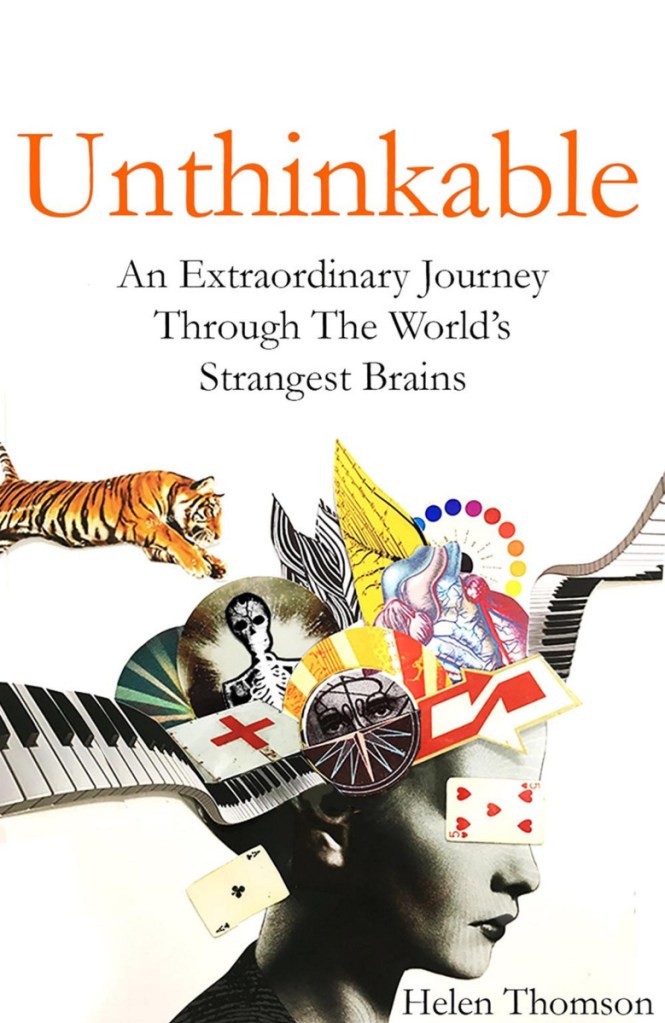Sometimes the best way to understand how a “normal” brain works is to explore those that are unique. Such is the insight in reporter Helen Thomson’s enjoyable new book, “Unthinkable: An Extraordinary Journey Through the World’s Strangest Brains.” Unsatisfied with the “cold and impersonal” accounts that make up the bulk of modern case studies, she reaches out to the humans they feature to get a fuller picture of their lives. She goes one step further than her idol Oliver Sacks: Instead of interviewing them in a clinical setting, she meets them on their own turf – in their homes, favorite restaurants and other haunts of regular life. What is it like, she constantly asks, to live with a brain that is so incredibly different?
Her nine subjects, mostly identified only by their first names, all have decidedly unusual conditions. Bob (highly superior autobiographical memory) can remember every single day of his life, Graham (Cotard’s syndrome) believed he was dead for three years, and Sharon is perpetually lost in her own house. Each person’s story anchors a chapter, and Thomson’s conversations with her subjects are liberally interspersed with background information and famous experiments. Together they take the reader on an engaging tour inside the head, from the hippocampus to the temporal lobe, explaining how we use the different parts of our brain in everyday life.
Most of the individuals we meet have adapted to maintain fairly ordinary lives, even when they have challenging and sometimes ironic conditions. Sylvia, who we meet in the sixth chapter, is nearly deaf, but since 2004 she has had vivid hallucinations of music. By concentrating on Bach, she has trained herself to mostly ignore the rest of the never-ending symphony of disjointed notes in her head. Then there is Joel, a physician whose mirror-touch synesthesia means he can literally feel his patients’ pain. While this almost certainly makes him a more successful and understanding doctor, he watches horror movies at home to temper the intensity of his feelings. The notable exception is the case of Matar, a schizophrenic who thinks he is a tiger. His condition prevents him from leading a normal life, and Thomson’s unsettling interview is cut off abruptly. His chapter ends with a sad coda.
A great science writer knows what is interesting to the reader, and here Thomson shines. Her book is tailor-made for anyone who loves intellectual brain trivia: why extroverts need more anesthesia, the advantage in wearing red on a date, the murdered priest behind the first lie detector. If this isn’t your first brain/psych/neuro-anything rodeo, then you will recognize examples like Phineas Gage, but she elaborates on even the well-known cases, bringing much-needed context and depth. She also has a gift for metaphor. At one point she describes the relative importance of different functions of the brain by comparing it to a car. While you absolutely must have an engine or gas to make it run, parts like windshield wipers and a steering wheel ensure that the experience is safe and pleasurable.
Along the way she corrects several popular misconceptions about our brains. It turns out we aren’t left- and right-brained so much as top- and bottom-brained, with, roughly speaking, the top part of the brain specializing in taking action and the bottom part in doing analysis. What you want is a relative balance between the two, but if one dominates too strongly, you may either act too impulsively or fail to act at all.
One of the most fun features of Thomson’s book is that she addresses the reader directly, enthusiastically suggesting tips to try at home and do-it-yourself diagnostics for your brain. If you’ve ever walked into a room and forgotten what you planned to do, try quickly looking left and right to help jog your memory. Or if you are feeling more ambitious and want to safely (and without drugs) explore hallucinations through the ganzfeld technique, all you need to make your own sensory deprivation chamber is a sawed-in-half ping-pong ball, some good noise-canceling headphones and unobtrusive lighting. Who knew?
Perhaps the most poignant chapter is the story of Tommy McHugh, whose personality completely changed after he suffered a stroke. He goes from being an emotionless, quasi-menacing figure with a criminal record to becoming a sensitive, compulsive painter with a deep reverence for life. His daughter describes his horrific brain injury as giving him a clean slate. While by all accounts he becomes a much kinder, happier person, his mother never quite trusts that he won’t go bad again. His story brings up philosophical questions about redemption and guilt, and to what extent we are responsible for our actions. McHugh dies of liver disease while Thomson is working on her book, but in his moving last email to the author, he writes: “I look at my reflection in the mirror Helen. A stranger I see. But a happy one, xxxx to all.”
It’s reflections like these that make you wonder about the true nature of self. Do we have free will, or are we just a function of our particular brain anatomy? As with the majority of what we learn in “Unthinkable,” it’s complex, and we don’t have nearly enough answers. Mostly, though, this book is a chef’s tasting menu of fascinating things about your brain – and a good one at that.
Send questions/comments to the editors.



Comments are no longer available on this story